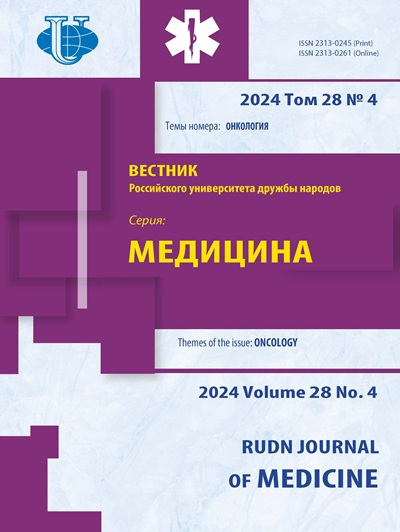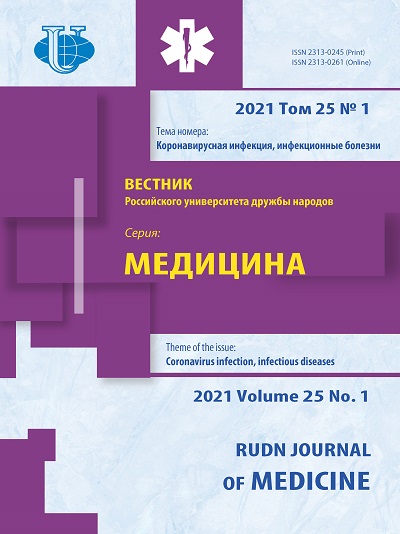Корреляция окислительного стресса с маркерами метаболического синдрома в клинических случаях гипотиреоза: исследование на базе больницы в отдаленном племенном районе
- Авторы: Панда С.1, Даш М.К.1, Татой П.К.2, Дандапат Д.3, Рат Б.4
-
Учреждения:
- Медицинский колледж Пандита Рагхунатха Мурму
- Медицинский колледж Шрирама Чандры Бханджа
- Уткальский университет
- Университет Норт-Одиша
- Выпуск: Том 25, № 1 (2021): КОРОНАВИРУСНАЯ ИНФЕКЦИЯ, ИНФЕКЦИОННЫЕ БОЛЕЗНИ
- Страницы: 55-65
- Раздел: ЭКСПЕРИМЕНТАЛЬНАЯ И КЛИНИЧЕСКАЯ ФИЗИОЛОГИЯ
- URL: https://journals.rudn.ru/medicine/article/view/25438
- DOI: https://doi.org/10.22363/2313-0245-2021-25-1-55-65
Цитировать
Полный текст
Аннотация
Актуальность . Дислипидемия является одним из основных проявлений процесса заболевания щитовидной железы из-за изменения метаболических параметров, которые также наблюдаются при метаболическом синдроме. Хотя в оба процесса вовлечен окислительный стресс, результаты различных исследований достаточно противоречивые. Цель: определить статус продукта перекисного окисления липидов (Lpx) в исследуемой группе и выявить взаимосвязь различных компонентов метаболического синдрома. Материалы и методы. Группу исследования составили 102 пациента, из них 60 здоровых пациентов с эутиреоидным контролем и 42 пациента с гипотиреозом. Образцы крови были собраны для определения уровня сахара в крови натощак, параметров почек, липидного профиля, трийодтиронина (Т3), тироксина (Т4) и тиреотропного гормона (ТТГ). Уровень перекисного окисления липидов в образцах определяли путем мониторинга уровня веществ, подобных тиобарбитуровой кислоте, подобных веществ и дугим. Результаты. Демографические параметры были значительно изменены у пациентов с гипотиреозом. Было обнаружено, что систолическое и диастолическое артериальное давление в обеих группах имеет более высокое среднее значение у пациентов с гипотиреозом. Уровень сахара в крови натощак, общий холестерин, триацилглицерин, липопротеины низкой плотности и липопротеины высокой плотности в гипотиреозе были значительно выше, чем в контрольных группах с эутиреоидом. Наиболее частым изменением у пациентов с гипотиреозом было повышение САД (95 %), гипертриглицеридемия (50 %), увеличение окружности талии (48 %) и ДАД (42 %). У пациентов с гипотиреозом наблюдалось четырехкратное увеличение Lpx (p <0,001). Между ТТГ и перекисным окислением липидов наблюдалась стойкая положительная связь. Множественные линейные регрессии выявили сильнейшую и статистически значимую связь между тиреотропным гормоном сыворотки и окружностью талии. Выводы . Пациенты с гипотиреозом имеют значительно более высокую степень окислительного стресса и компонентов метаболического синдрома. Они являются кандидатами на профилактическое медицинское вмешательство.
Ключевые слова
Об авторах
С. Панда
Медицинский колледж Пандита Рагхунатха Мурму
Автор, ответственный за переписку.
Email: dr.suchismitapanda17@gmail.com
г. Барипада, Одиша, Индия
Манодж К. Даш
Медицинский колледж Пандита Рагхунатха Мурму
Email: dr.suchismitapanda17@gmail.com
г. Барипада, Одиша, Индия
Прават К. Татой
Медицинский колледж Шрирама Чандры Бханджа
Email: dr.suchismitapanda17@gmail.com
г. Каттак, Одиша, Индия
Д. Дандапат
Уткальский университет
Email: dr.suchismitapanda17@gmail.com
г. Бхубанешвар, Одиша, Индия
Б. Рат
Университет Норт-Одиша
Email: dr.suchismitapanda17@gmail.com
г. Барипада, Одиша, Индия
Список литературы
- Pasupathi PP, Latha R. Free Radical Activity and Antioxidant Defense Mechanisms in Patients with Hypothyroidism. Thyroid Sci 2008;3(12):CLS1-6.
- Nivedita N, Bobby Z, Abdoul H. Association of lipid risk factors with lipid peroidation in hypothyroidism. Clin Chem Lab Med 2008;46(5):674-679.
- Santi A, Duarte MM, deMenezes CC, Loro VL. Association of Lipids with Oxidative Stress Biomarkers in Subclinical Hypothyroidism. Int J Endocrinol. 2012:Article ID 856359, doi: 10.1155/2012/856359.
- Turhan S, Sezer S, Erden G. et al. Plasma homocysteine concentrations and serum lipid profile as atherosclerotic risk factors in subclinical hypothyroidism. Ann Saudi Med. 2008;28(2):96-101.
- Hueston WJ. and Pearson WS. Subclinical hypothyroidism and the risk of hypercholesterolemia. Annals Family Med. 2004;2(4):351-355.
- Baskol G, Atmaca H, Tanriverdi F, Baskol M, Kocer M, Bayram F. Oxidative stress and enzymatic antioxidant status in patients with hypothyroidism before and after treatment. Experi Clin Endocrinol Diab. 2007;115(8):522-526.
- Torun AN, Kulaksizoglu S, Kulaksizoglu M, Pamuk BO, Isbilen E, Tutuncu NB. Serum total antioxidant status and lipid peroxidation marker malondialdehyde levels in overt and subclinical hypothyroidism. Clin Endocrinol. 2009;70(3):469-474.
- Messarah M, Boumendjel A, Chouabia A. et al. Influence of thyroid dysfunction on liver lipid peroxidation and antioxidant status in experimental rats. Experi Toxicol Pathol. 2010;62(3):301-310.
- Rizos CV, Elisaf MS, Liberopoulos EN. Effects of thyroid dysfunction on lipid profile. Open Cardiovasc Med J. 2011;5:76-84.
- Wolffenbuttel BHR, Wouters HJCM, Slagter SN. et al. Thyroid function and metabolic syndrome in the population based Life Lines cohort study. BMC Endocrine Disorders. 2017;17(1), p. 65.
- World Health Organization. Obesity: preventing and managing the global epidemic. Report of a WHO Consultation on Obesity. Geneva: The Organization (WHO Technical Report Series, No. 894), 2000.
- Expert Panel on Detection, Evaluation, and Treatment of High Blood Cholesterol In Adults 2001 Executive Summary of The Third Report of The National Cholesterol Education Program (NCEP) Expert Panel on Detection, Evaluation, And Treatment of High Blood Cholesterol In Adults (Adult Treatment Panel III). JAMA. 285:2486-2497.
- Efstathiadou Z, Bitsis S, Milionis HJ. et al. Lipid profile in subclinical hypothyroidism: is L-thyroxine substitution beneficial? European J Endocrinol. 2001;145(6):705-710.
- Yildirimkaya M, Zata MO, Yilmaz K, Kilinc C¸ G¨undoˇgan MA, Kutluay T. Lipoprotein (a) concentration in subclinical hypothyroidism before and after levo-thyroxine therapy. Endocrine J. 1996;43(6):731-736.
- Miura S, Iitaka M, Yoshimura H. et al. Disturbed lipid metabolism in patients with subclinical hypothyroidism: effect of L-thyroxine therapy. Internal Med. 1994;33(7):413-417.
- Turhan S, Sezer S, Erden G. et al. Plasma homocysteine concentrations and serum lipid profile as atherosclerotic risk factors in subclinical hypothyroidism. Annals Saudi Med. 2008;28(2): 96-101.
- Lu L, Wang B, Shan Z. et al. The correlation between thyrotropin and dyslipidemia in a population-based study. J Korean Med Sci. 2011;26(2):243-249.
- Diekman T, Demacker PN, Kastelein JJ, Stalenhoef AF, Wiersinga WM. Increased oxidizability of low density lipoproteins in hypothyroidism. J Clin Endocrinol Metab. 1998;83:1752-5.
- Olinescu R, Radaceanu V, Nita S, Lupeanu E. Age dependent variations of the plasma peroxides and total antioxidants inwomen with obesity and hypothyroidism. Rom J Intern Med. 1992;30:285-90.
- Aizawa K, Shoemaker JK, Overend TJ, Petrella RJ. Metabolic syndrome, endothelial function and lifestyle modification. Diab Vasc Dis Res. 2009;6:181-189.
- Bhimte B, Agrawal BK, Sharma VK, Chauhan SS. Oxidative stress status in hypothyroid patients. Biomed Res. 2012;23(2):286-288.
- Messarah M, Boumendjel A, Chouabia A. et al. Influence of thyroid dysfunction on liver lipid peroxidation and antioxidant status in experimental rats. Experi Toxicol Pathol. 2010;62(3):301-310.
- Nanda N, Bobby Z, Hamide A. Association of thyroid stimulating hormone and coronary lipid risk factors with lipid peroxidation in hypothyroidism. Clinical Chem Lab Med. 2008;46(5):674-679.
- Solanki A, Bansal S, Jindal S. et al. Relationship of serum thyroid stimulating hormone with body mass index in healthy adults. Indian J Endocrinol Metab. 2013; 17(Suppl1):S167.
- Xu B, Yang H, Wang Z. et al. Elevated thyroid stimulating hormone levels are associated with metabolic syndrome in a Chinese community-based population of euthyroid people aged 40 years and older. J Biomed Res. 2016;30:476.
- Ceriello A, Motz E. Is oxidative stress the pathogenic mechanism underlying insulin resistance, diabetes, and cardiovascular disease? The common soil hypothesis revisited. Arterioscler Thromb Vasc Biol. 2004;24:816-823.
- Van Guilder G.P., Hoetzer G.L., Greiner J.J., Stauffer B.L., Desouza CA. Influence of metabolic syndrome on biomarkers of oxidative stress and inflammation in obese adults. Obesity (Silver Spring). 2006;14:2127-2131.
- Skalicky J, Muzakova V, Kandar R, Meloun M, Rousar T, Palicka V. Evaluation of oxidative stress and inflammation in obese adults with metabolic syndrome. Clin Chem Lab Med. 2008; 46: 499-505.
- Sa´nchez-Rodrı´guez M, Martı´nez-Cruz M, Correa-Mun˜oz E, Mendoza-Nu´n˜ez V. Relationship between metabolic syndrome components and oxidative stress in elderly community-dwelling Mexicans. Ann Nutr Metab. 2010;56: 302-307.
- Yilmaz S, Ozan S, Benzer F, Canatan H. Oxidative damage and antioxidant enzyme activities in experimental hypothyroidism. Cell Biochem Funct. 2003;21(4):325-330.
- Carmeli E, Bachar A, Barchad S, Morad M, Merrick J. Antioxidant status in the serum of persons with intellectual disability and hypothyroidism: A pilot study. Res Development Disab. 2008;29:431-438.
- Cotillard A, Poitou C, Torcivia A, Bouillot JL, Dietrich A, Klöting N, et al. Adipocyte size threshold matters: link with risk of type 2 diabetes and improved insulin resistance after gastric bypass. J Clin Endocrinol Metab. 2014; 99(8):E1466-70.
- Skurk T, Alberti-Huber C, Herder C, Hauner H. Relationship between adipocyte size and adipokine expression and secretion. J Clin Endocrinol Metab. 2007;92(3):1023-33.
- Hernanz R, Briones AM, Salaices M, Alonso MJ. New roles for old pathways? A circuitous relationship between reactive oxygen species and cyclo-oxygenase in hypertension. Clin Sci (Lond). 2014;126(2):111-21.
- Ward NC, Hodgson JM, Puddey IB, Mori TA, Beilin LJ, Croft KD. Oxidative stress in human hypertension: association with antihypertensive treatment, gender, nutrition, and lifestyle. Free Radic Biol Med. 2004;36(2):226-32.
- Tangvarasittichai S. Oxidative stress, insulin resistance, dyslipidemia and type 2 diabetes mellitus. World J Diabetes. 2015;6(3):456-80.
















